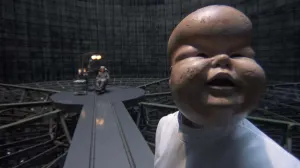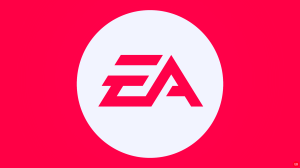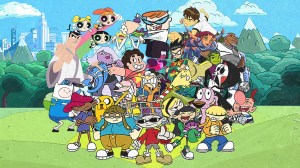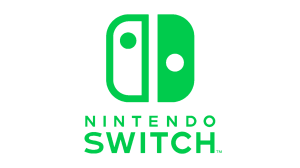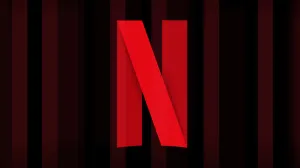Travis Touchdown returns in No More Heroes III for Nintendo Switch, releasing on August 27th. Developed by Grasshopper Manufacture, it’s the first numbered sequel in the No More Heroes series in over a decade. Fans of the series and creator Goichi “Suda51” Suda’s distinctive style of games have eagerly anticipated this release for years. However, newcomers may be at a loss for why No More Heroes has such a strong cult following and whether or not they should care about the latest installment. We’re hoping to help out with that through this guide to the No More Heroes series to date.
Videos by ComicBook.com
If you’re new to No More Heroes or want a refresher on the series, this article should help you out. Come and enter the Garden of Madness.

What is No More Heroes?
Grasshopper Manufacture develops the No More Heroes games, conceived by the studio’s founder, Goichi Suda, also known as Suda51. Suda is one of the more “auteur” creators in the game industry. He first gained notoriety for creating one of the earliest psychological horror games, Moonlight Syndrome, and sneaking a story mode ending into a 1994 Fire Pro Wrestling game that was dark and unexpected enough to elicit death threats. (He got invited back to write a sequel as DLC for Fire Pro Wrestling World in 2020). Upon sensing that the studio he worked for was about to go under, he left to form Grasshopper Manufacture in 1998 with other members of the Moonlight Syndrome team.
The No More Heroes games are a subseries in Suda51’s “Kill the Past,” a collection of interconnected games that include Suda’s earlier cult hits The Silver Case and Killer7, which share themes, characters, and sometimes reference each other’s plots. Those games all occur in a more expansive shared universe, sometimes called the “Sudaverse,” which encompasses Suda51’s entire oeuvre since founding Grasshopper Manufacture, including some unrelated to “Kill the Past” like Shadows of the Damned and Killer Is Dead.
You don’t need to know about “Kill the Past” or the Sudaverse to enjoy No More Heroes. Suda designed these games to stand on their own, with the first No More Heroes only containing a few “Kill the Past” Easter eggs and the sequel not referencing it at all. Travis Strikes Again is another story, but we’ll get to that. The point is, don’t let this stuff scare you off. No More Heroes as a franchise is its own thing that can serve as a gateway to Suda’s other works, if that’s something you become interested in. (“Kill the Past” is beyond the scope of this article, but the blog Rain, Sun, and Flower put together a great primer if you want to go down that road.)
What kind of games are No More Heroes?
No More Heroes and No More Heroes 2: Desperate Struggle are third-person, 3D action games. Players control Travis Touchdown, who fights using his eBay-purchased “beam katana” and pro-wrestling moves. The combat is fast-paced and visceral in the style of hack-and-slash action games. Kills come quick and are bloody.
As a spinoff, Travis Strikes Again: No More Heroes is a little different. It maintains the series’ fast-paced action but goes isometric in an homage to indie and retro games while introducing new powers into the mix.
What sets the No More Heroes games apart from other action games is Suda’s eclectic aesthetic. No More Heroes has a metatextual layer to it as Suda alternately celebrates and criticizes gaming culture. It’s a Quentin Tarantino-esque blend of grindhouse violence and anything-can-happen-and-damn-the-explanations storytelling that forms a tense and exciting experience. Suda’s games can be intentionally offputting and profoundly personal and unlike anything else in the gaming market, at least at this budget level.
What are the games in the No More Heroes series?
Confusingly, No More Heroes III will be the fourth game in the series (not counting the Japan-exclusive mobile game No More Heroes World Ranker). These games are now available on the Nintendo Switch, which is the ideal way to play them.
We’re going to break down the basic plots and themes here. We’ll try to keep things vague for those who want to play the series from the beginning, but SPOILERS will inevitably follow.
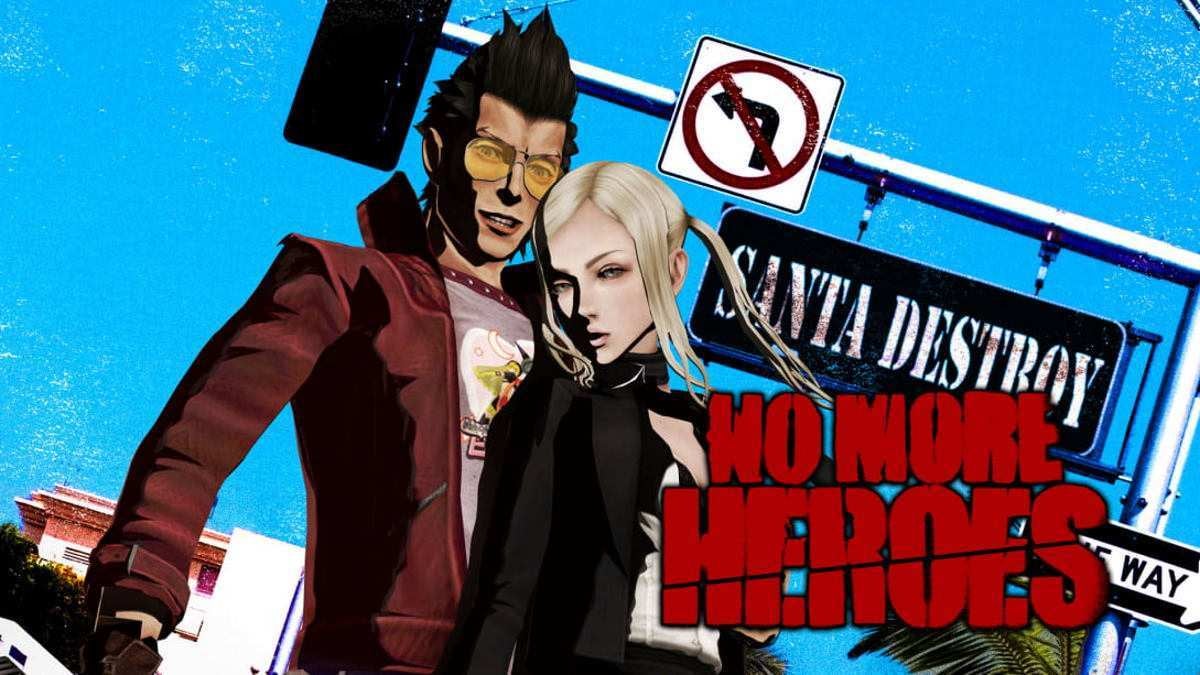
No More Heroes
Grasshopper released the first No More Heroes game in 2007 for the Nintendo Wii and introduced Travis Touchdown as a loser otaku living in the coastal U.S. city of Santa Destroy. He purchased a beam katana and entered the United Assassins Association to get a woman he met at a bar named Sylvia Crystal to sleep with him. But until Travis reaches the top spot in the ranks, she’s only there as an agent helping set up the matches.
For those who played the first No More Heroes, it was like a bolt of lighting. It’s chock full of action and over-the-top boss fights. The game makes excellent use of the console’s motion controls by having players swing the Wiimote to deliver finishing blows and perform a, uh, suggestive up-and-down hand motion to recharge their weapon. It’s also a thoughtful game satirizing traditional hero’s journey narrative. The game’s title has three (at least) meanings. Suda51 has said it refers to Travis killing his heroes (other assassins) to reach the top of the charts, but that’s the plain text reading.
No More Heroes also means “no more hero’s journey.” The game repeatedly satirizes the trite, predictable heroic narratives that are the default setting for most big-budget video games with a plot. The game frequently uses Star Wars as a touchpoint for this kind of storytelling since George Lucas’ films made such stories famous. The most obvious reference is Travis fighting with a janky lightsaber knockoff. There are others as well, including Travis’ mentor getting killed (not as big as a spoiler as you might think) but returning to continue training and guiding him as a ghost, and some wild, out-of-left-field plot twists involving secret family members. Towards the end of the game, there’s even a character who shows up looking vaguely like Darth Vader, who claims he’s Travis’s father and deploys minions who look a bit like Stormtroopers.
Finally, No More Heroes wants players to admit that they are not playing video games because they want to be the heroes these rote narratives depict. Travis is a surrogate gamer, having to go to work (play minigames) to fund his power fantasies (assassin missions, i.e., playing the game). No More Heroes repeatedly gets in players’ faces with acts of violence and sexualization in an attempt to get players to own up to primarily playing the game for the titillation. Suda isn’t judging gamers, but he does want them to be honest with themselves.
There’s a lot on No More Heroes‘ surface that might turn folks away, justifiably. It does bask in its gore, and its lead’s ironically juvenile behavior, particularly with regards to the male gaze. But it’s also a brilliant work of gaming metafiction that’s a ton of fun to play.

No More Heroes 2: Desperate Struggle
No More Heroes 2: Desperate Struggle debuted in 2010 to much weaker sales than its predecessor. Suda, busy working with Electronic Arts on projects like Shadows of the Damned, didn’t direct this entry in the series. Despite having much more refined and streamlined gameplay, Suda’s reduced role may be why No More Heroes 2 has the reputation of being the black sheep of the series.
No More Heroes 2‘s story is much more straightforward than its predecessor’s, with Travis attempting to climb the assassin rankings again. This time his goal is to get revenge on the pizza mogul at the top for killing his best friend. It still has the humor and over-the-top antics of the original but less narrative depth.
Charitably, you could say that the story satirizes revenge narratives the way the first game mocked heroic narratives. You could also say that it’s a slightly more hopeful story, showing that even Travis Touchdown can mature, suggesting the same is possible for the gamers he represents. I think both are true, but the experience doesn’t transcend its basic premise the same way the first game does.
Having replayed the game recently, it’s much better than my memory suggested. It may not reach the original’s heights, but it’s still a worthwhile entry in the series.
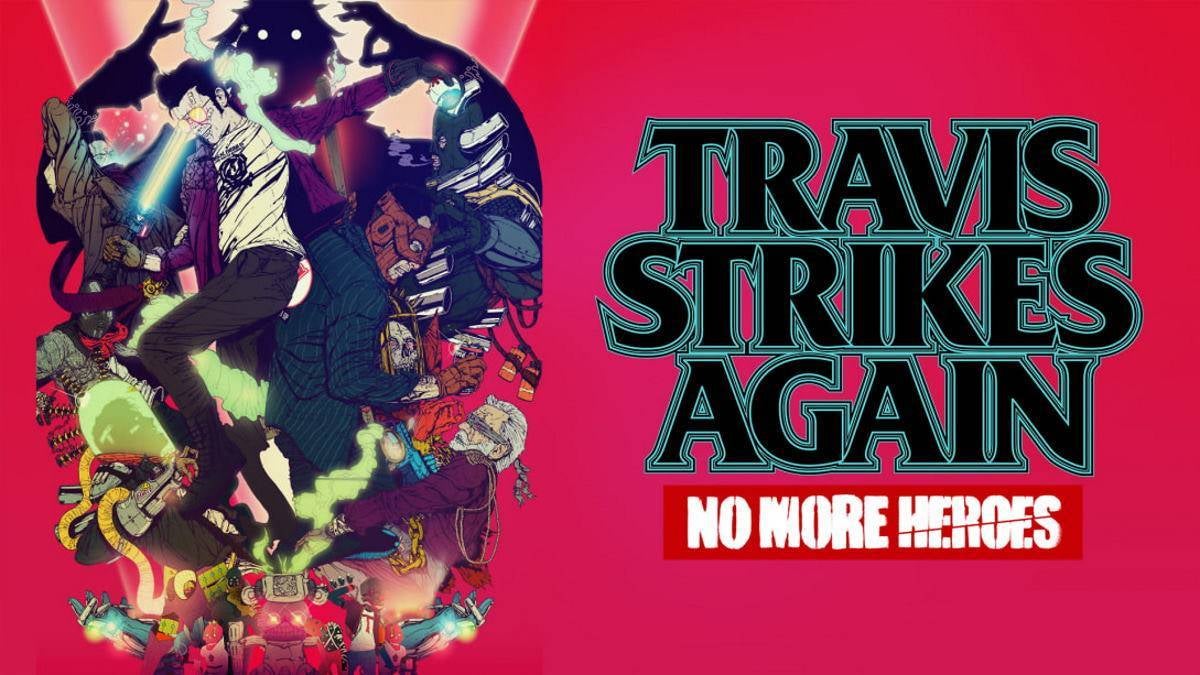
Travis Strikes Again: No More Heroes
Almost a decade after Desperate Struggle, the Nintendo Switch’s motion-sensitive Joy-Con controllers inspired Suda51 to bring Travis Touchdown back. Grasshopper would eventually announce No More Heroes III, but Suda first wanted to reintroduce his otaku assassin in a smaller-scale spinoff called Travis Strikes Again.
Travis Strikes Again redefines who Travis is as a character. He’s aged in real-time, and now, instead of being an insert for gamers, he’s more a cipher for Suda himself. Suda did not have a great experience working with Electronic Arts. Though he’s proud of Shadows of the Damned, the project started as an entirely different game. According to Suda, EA forced him to rewrite the script five times until the game was unrecognizable as what he originally pitched (which he’d later adapt into the manga Kurayami Dance).
Travis Strikes Again finds Travis living alone in a trailer playing video games for 10 hours a day in the middle of nowhere. He only springs back into action when Badman comes looking for revenge for his daughter, one of the assassins Travis defeated in the first game. They both get sucked into the video game worlds of the Death Drive Mk. II, an unreleased video game console thought of mainly as an urban legend that Travis somehow acquired. Players take control of Travis (or Badman) and play through six different video game worlds that are riffs on existing real-world video games, including one that’s a sequel to Shadows of the Damned.
Travis Strikes Again is about as personal a narrative as I’ve encountered in a video game with a big enough budget to get a retail release. Through Travis, Suda51 wrestles with his feelings about continuing to work in the games industry. He does this by reconnecting with the types of games that made him want to become a designer in the first place and celebrating the modern indie games that continue to inspire him (many of which feature on collectible t-shirts in the game).
It’s also about Suda and Grasshopper celebrating their achievements. Travis Strikes Again doubles as a 20th-anniversary project for Grasshopper Manufacture and includes cameos from several characters from other games in the company’s history, including a few that seem poised to return in No More Heroes III. The action happens in Death Drive game worlds, but most of the story occurs in “Travis Strikes Back,” a pseudo-game within Travis Strikes Again that harkens back to Suda’s early days working on visual novels. It’s Suda and company reveling in what they’ve created while at the same time revitalizing themselves for future efforts.
Ultimately, Travis (and Suda) come through it all feeling reenergized and entirely devoted to this art form they love, shedding corporate concerns, and realigned themselves with the independent punk rock spirit that informed Suda’s signature style. Suda tried to play nice with the big publishers, but they didn’t play nice back, and Travis Strikes Again is a surprisingly emotional and cerebral game about making peace with that and moving on to the next thing.
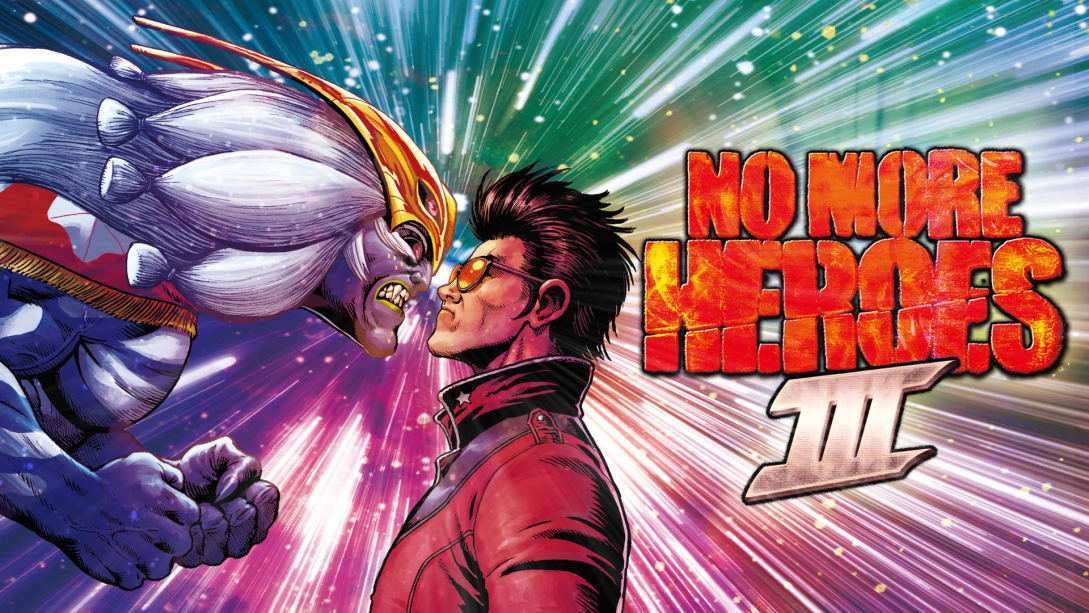
No More Heroes III
No More Heroes III sees Suda51 increasing the scale for Travis considerably. Instead of fighting earthly assassins, he’s going into the intergalactic superhero rankings and battling aliens.
We can’t say too much about what else is in store since we haven’t played the game yet. It seems likely that Suda is turning his satirical eye towards superheroes, which may be why he tapped The Boys co-creator Darick Robertson to create promotional artwork for the game. Furthermore, these so-called superheroes coming to Earth ally themselves with the head of a massive corporation called Utopinia, which maintains a squeaky clean image and that had been on the cusp of turning Santa Destroy into the site of their new Utopiland theme park. Ring any bells?
From the gameplay we’ve seen, it looks like Travis will have a lot more tools at his disposal. That’s probably for the best since his enemies being aliens this time around means Suda and his team can shed whatever semblance of realism they were hanging onto when it comes to creating new enemies. Expect the most advanced version of No More Heroes‘ gameplay yet.
No More Heroes’ characters
Travis Touchdown is, obviously, the most important character in the No More Heroes franchise. While the games tend to introduce lots of new antagonists for Travis to face, there are also a few recurring characters that have become allies with Travis.
Here is a list of supporting characters from the No More Heroes games that have returned as recently as in Travis Strikes Again. Some are confirmed to return in No More Heroes III. These descriptions are brief but contain a few spoilers to help you be on the right page at the time No More Heroes III begins:
- Sylvia Christel: The woman Travis fought for in the original No More Heroes. She works for the UAA, setting up Travis’ ranked matches. As of Travis Strikes Again, they’re married with two children, though Travis had been living separately to protect his family from the constant string of assassins coming for his head.
- Shinobu Jacobs: Shinobu once wrongly believed that Travis killed her father. Travis defeated her in the first No More Heroes but spared her life. She returned the favor by later saving his life. Now she considers herself Travis’s loyal apprentice.
- Bad Girl: A baseball bat-wielding assassin Travis killed in the first No More Heroes. Travis and Badman resurrected her in Travis Strikes Again.
- Badman: An assassin and Bad Girl’s father. He attacked Travis in Travis Strikes Again, seeking revenge for Bad Girl’s death. He ended up working together with Travis and resurrecting Bad Girl instead.
- Henry Cooldown: Travis’ brother and Sylvia’s ex-husband. Travis didn’t know Henry existed until the first No More Heroes. In No More Heroes 2, they seemed to bury the hatchet and become allies. Since then, Travis Strikes Again revealed Henry’s personality had undergone a massive change. Henry now leads a cult called the Order of the Emerald Night, dedicated to killing Travis.
- Bishop: Travis’ best friend (brother of his previous best friend, killed in No More Heroes 2). He runs the Beef Head video store in Santa Destroy.
Which games should you play before No More Heroes III?
It’s hard to say without playing through No More Heroes III first. In general, the No More Heroes games tend to be bursting with ideas that will capture your attention and keep you entertained while your brain eventually contextualizes the plot point. In other words, you can probably jump right in and have a great time, catching up and parsing the plot as you go.
If you play only one game before No More Heroes III, it should probably be Travis Strikes Again. As mentioned, it’s a turning point for Travis’ characterization that seems likely to set the stage for his arc in No More Heroes III. No More Heroes III‘s plot also seems to pick up most directly from where Travis Strikes Again left off, with Travis Strikes Again‘s Bubblegum Fatale DLC serving as a prologue that introduces two aliens in non-combative roles. Certain supporting characters from Travis Strikes Again will return, and the Death Drive glove that gives Travis special powers will also crossover into No More Heroes III.
However, if you have time, while it isn’t necessary to play the previous No More Heroes games, it is worthwhile and will provide a fuller picture of Travis’s arc. The first is a brilliant work of gaming art, and the second, while not as ambitious, is still an enjoyable follow-up. Both are available on Switch now with HD graphics, using the Joy-Cons in place of the old Wiimote and nunchuck, and are reasonably priced.
Now you’re caught up and ready to take on No More Heroes III. The game releases on August 27th on Nintendo Switch.

